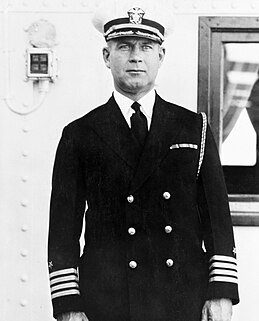
Isaac Campbell Kidd was an American Rear Admiral in the United States Navy. He was the father of Admiral Isaac C. Kidd, Jr. Kidd was killed on the bridge of USS Arizona during the Japanese attack on Pearl Harbor. The highest ranking casualty at Pearl Harbor, he became the first U.S. Navy flag officer killed in action in World War II as well as the first killed in action against any foreign enemy.
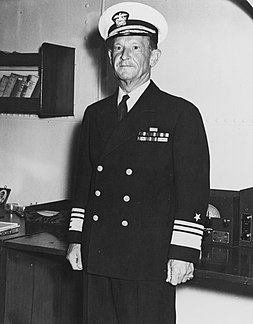
Frank Jack Fletcher was an admiral in the United States Navy during World War II. Fletcher was the operational commander at the pivotal Battles of Coral Sea and of Midway. As a lieutenant, Fletcher was awarded the Medal of Honor for his actions in the battle at Veracruz. He was the nephew of Admiral Frank Friday Fletcher, who was also awarded the Medal of Honor for actions at Veracruz.
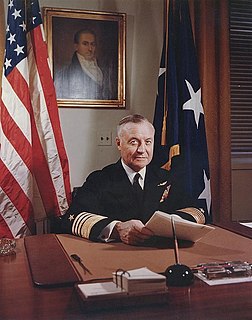
Forrest Percival Sherman was an admiral in the United States Navy and the youngest person to serve as Chief of Naval Operations until Admiral Elmo Zumwalt in 1970. The Forrest Sherman-class destroyer was named for him.

Norman (Nicholas) Scott was a rear admiral in the United States Navy, and was one of only two U.S. Navy admirals killed in action during a surface battle in World War II. Scott posthumously received the Medal of Honor for his actions in the Pacific Theater of World War II.
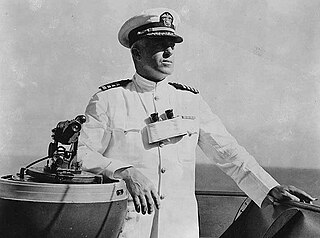
Daniel Judson Callaghan was a United States Navy officer who received the Medal of Honor posthumously for his actions during the Naval Battle of Guadalcanal. In a career spanning just over 30 years, he served his country in two wars. He served on several ships during his first 20 years of service, including escort duties during World War I, and also filled some shore-based administrative roles. He later came to the attention of US President Franklin Roosevelt, who appointed Callaghan as his naval aide in 1938. A few years later, he returned to command duties during the early stages of World War II. Callaghan was killed by an enemy shell on the bridge of his flagship, USS San Francisco, during a surface action against a larger Japanese force off Savo Island. The battle ended in a strategic victory for the Allied side.

Hiroaki Abe was an admiral in the Imperial Japanese Navy during World War II.

Vice Admiral Morton Lyndholm Deyo was an officer in the United States Navy, who was a naval gunfire support task force commander of World War II.

Charles Turner Joy was an admiral of the United States Navy during World War II and the Korean War. During the last years of his career, while fighting leukemia, he served as Superintendent of the Naval Academy. The destroyer USS Turner Joy (DD-951) was named for him.

USS Monssen (DD-436), a Gleaves-class destroyer, was the first ship of the United States Navy to be named for Mons Monssen, who was awarded the Medal of Honor for his actions aboard USS Missouri (BB-11) in 1904. Commissioned in 1941, the destroyer saw service during World War II in both Atlantic and Pacific Oceans. Monssen was sunk at the Naval Battle of Guadalcanal on 13 November 1942.

David Worth Bagley was an admiral in the United States Navy during World War II. He was also the brother of Ensign Worth Bagley, the only United States Navy officer killed in action during the Spanish–American War, and the father of Admirals David H. Bagley and Worth H. Bagley.
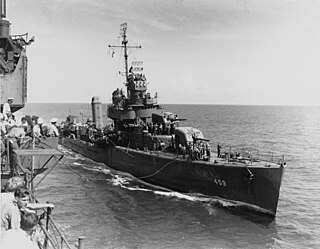
USS Laffey (DD-459) was a Benson-class destroyer of the United States Navy during World War II. She was the first destroyer named for Bartlett Laffey.
Thomas Edward Fraser was an officer in the United States Navy.

Harry Wilbur Hill was an admiral in the United States Navy during World War II.
Damon M. Cummings was a United States Navy officer who received a posthumous Navy Cross for his actions during World War II.

Paul J. Register was a United States Navy officer killed in action during the attack on Pearl Harbor for whom two U.S. Navy ships were named.

Milton F. Pavlic (1909–1942) was a United States Navy officer killed in action during World War II for whom a U.S. Navy high-speed transport was named.
Vice Admiral Ferdinand Louis Reichmuth was an officer of the United States Navy who served in World War I and World War II.

Robert Ward Hayler was a highly decorated officer in the United States Navy with the rank of Vice admiral. He was a three time recipient of the Navy Cross, the Navy's second highest military decoration for valor. Two of these awards received while served as Commanding officer of light cruiser USS Honolulu at Guadalcanal and Kula Gulf and third as Rear admiral and Commander, Cruiser Division Twelve during the Battle of Surigao Strait in October 1944.

Lloyd Montague Mustin was a vice admiral in the United States Navy and among the namesakes of USS Mustin (DDG-89). He took part in developing the Navy's first lead-computing anti-aircraft gun sight, which proved of major importance in the air-sea actions of World War II, and he served on the cruiser USS Atlanta during the naval battle of Guadalcanal. His ship was lost during that action, and with other survivors he landed on Guadalcanal and served ashore with a naval unit attached to the First Marine Division. His postwar service included commands at sea and development and evaluation of weapon systems. He later served as director of operations for the Joint Chiefs of Staff during the Vietnam War.

Laurance Toombs DuBose was a highly decorated officer in the United States Navy with the rank of four-star Admiral. A veteran of several conflicts, including both World Wars, he distinguished himself several times as Commanding officer of heavy cruiser USS Portland and Commander, Cruiser Division 13 in the Pacific theater of World War II and received three awards of Navy Cross, the United States Navy second-highest decoration awarded for valor in combat.

















